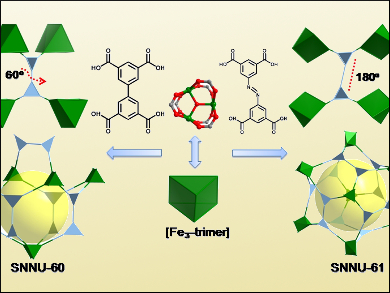Natural gas often contains impurities such as CO2 or C2 hydrocarbons, which need to be removed. Metal–organic frameworks (MOFs), consisting of a metal ion or cluster and multidentate organic ligands, are promising materials for gas uptake and separation. These materials have designable frameworks, high porosity, and high surface areas, but customizing the framework functionalities can be a challenge.
Quan-Guo Zhai and colleagues, Shaanxi Normal University, China, have used two similar quadrilateral carboxylate ligands with different lengths (3,3′,5,5′-biphenyl- and 3,3′,5,5′-azobenzenetetracarboxylic acid) to prepare MOFs containing Fe3 centers. The two resulting MOFs (pictured) have completely different frameworks owing to the different torsions between the benzene groups of the two ligands (60 and 180°, respectively).
Both materials display high thermal and chemical stability, microporosity, and excellent gas uptake capabilities for hydrogen, CO2, ethyne, and ethylene. Additionally, they can selectively separate CO2 and C2 hydrocarbons from methane, making them promising materials for methane purification and CO2 capture.
- Ligand Torsion Triggered Two Robust Fe-Tetratopic Carboxylate Frameworks with Enhanced Gas Uptake and Separation Performance,
Jian-Wei Zhang, Man-Cheng Hu, Shu-Ni Li, Yu-Cheng Jiang, Quan-Guo Zhai,
Chem. Eur. J. 2017.
DOI: 10.1002/chem.201700867


